3 Ways to Record All Kinds of Audio on Mac [Up to macOS 15]
There are three popular combinations of Mac audio recording:
- Record computer + microphone sound together
- Record computer audio only
- Capture microphone voice
- FAQs
Which one do you prefer? You can click the above link and quickly find related solutions below.
How to Record Internal and External Audio on Mac
AnyRec Screen Recorder provides easy-to-use audio recorder and video recorder for all Mac users. Whether you want to capture computer audio or screen record on Mac with audio, you can get quick solutions. Its customizable recording options and editing tools are also good to use.
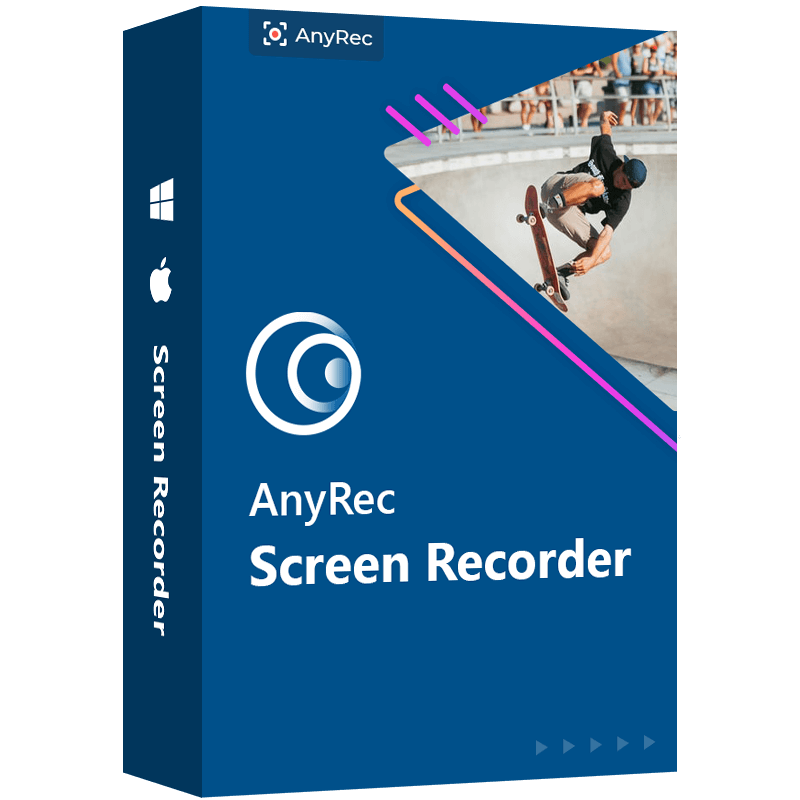
Capture audio from programs, browsers, microphones, etc.
Cut part of an audio recording before export.
Export audio to MP3, M4A, WMA, FLAC, CAF, OGG, and OPUS.
Record audio on MacBook Air/Pro up to macOS Sequoia 15.
Secure Download
Secure Download
Step 1.Open AnyRec Screen Recorder. Click the "Audio Recorder" button.
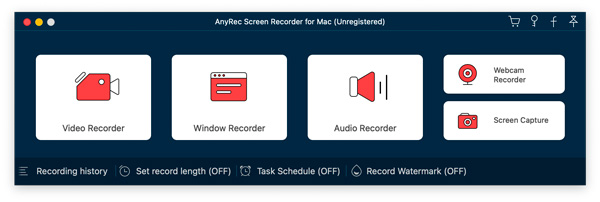
Step 2.Enable "System Sound" and "Microphone" toggle buttons based on your need.
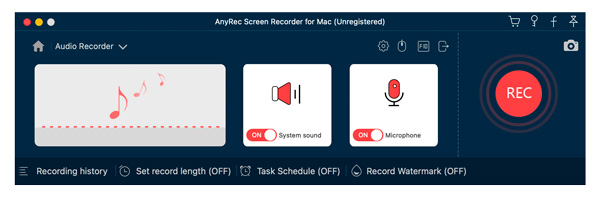
Step 3.Click the "REC" button. After a 3-second countdown, you can record audio on Mac from the selected sources.
Secure Download
Secure Download
How to Record System Audio on Mac
Though Mac provides two default screen recording tools, there still needs to be a direct way to record internal computer audio directly. You must install BlackHole or SoundFlower to make a successful Mac internal audio recording. Or you can use a third-party Mac audio recorder to bypass this virtual audio driver.
#1. AnyRec Screen Recorder
- Best for: High-quality audio and video recording of all activities on Mac.
You can record browser audio, program audio, microphone sound, online classes, lectures, and almost all sound on Mac by using AnyRec Screen Recorder. Beyond its audio recorder, you can trim unwanted audio clips before exporting. Moreover, its video recorder, window recorder, game recorder, and screen capture tool can meet your demands in most scenarios.
Secure Download
Secure Download
Step 1.Open AnyRec Screen Recorder for Mac. Click the "Audio Recorder" button.

Step 2.Enable the toggle button before "System Sound".
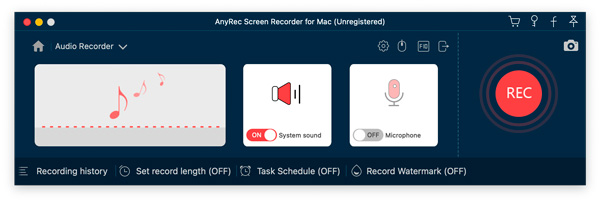
Step 3.Click the "Settings" button to change the output format, hotkeys, and other recording preferences. (Optional)
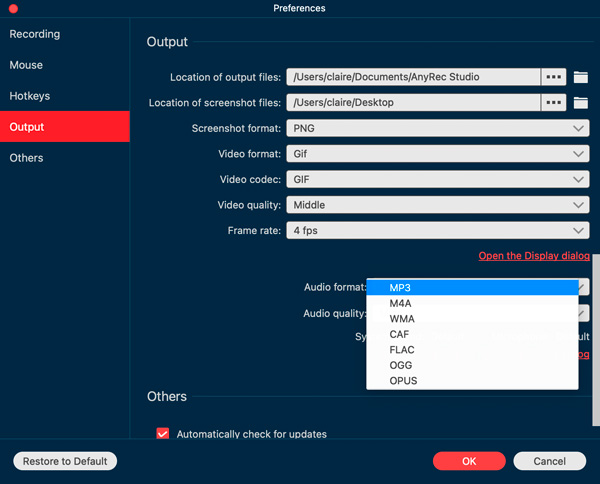
Step 4.Click the "REC" button to record audio on Mac from internal and external sources.
Step 5.Stop the audio recording. Pre-listen it. If it is okay, click the "Save" button to record and save audio to MP3 and other formats on Mac.

#2. BlackHole/SoundFlower & QuickTime Player
- Best for: Simple audio recording and then saving to M4A format on Mac.
Most Mac users are familiar with QuickTime Player as a powerful media player and recorder. But the first time you record Mac audio with QuickTime Player, you must first install BlackHole 2ch or Soundflower add-on. Change sound settings with this virtual audio recording tool. After that, you can do internal audio recording on Mac. This also works for the audio recorder from the Command, Shift, and five shortcut combinations on Mac.
Step 1.Download BlackHole from its official website. (You can download Soundflower safely from GitHub, Softonic, or MacUpdate.)
Step 2.Install with the on-screen prompts. Open QuickTime Player from Launchpad. Or you can find QuickTime by pressing Command, Shift, and 5 on your keyboard.
Step 3.Unfold the "File" top list. Click "New Audio Recording" from this list.
Step 4.Click the white down arrow icon. Select "BlackHole 2ch" (or Soundflower) under "Microphone".
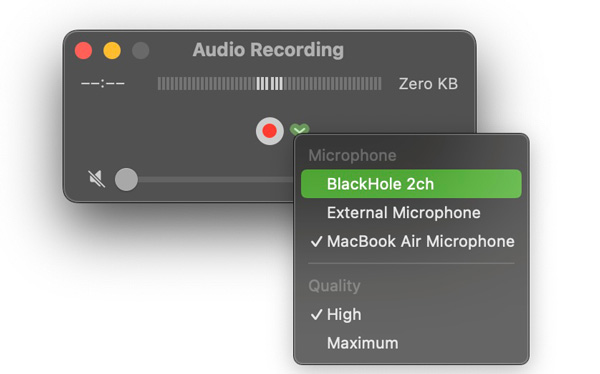
Step 5.Now you can record audio on Mac with QuickTime Player.
How to Record Voice on Mac
You can get more choices to record audio from a microphone on Mac. AnyRec Screen Recorder, Voice Memos, GarageBand, QuickTime Player, and many other programs can be your good choices. Here are the detailed steps of the first 2 Mac audio recorders.
#1. AnyRec Screen Recorder
- Best for: Capture microphone audio on Mac with or without screen recordings.
No matter you want to do voiceover or record your face with voice, you can try AnyRec Screen Recorder. Just choose the correct recorder from its main interface. Later, you can record audio with screen video, webcam, or nothing based on your need.
Secure Download
Secure Download
Step 1.Open AnyRec Screen Recorder after the installation. Click the "Audio Recorder" button.

Step 2.Enable the toggle button before "Microphone". You can click the "Settings" button to adjust the output audio format and quality.
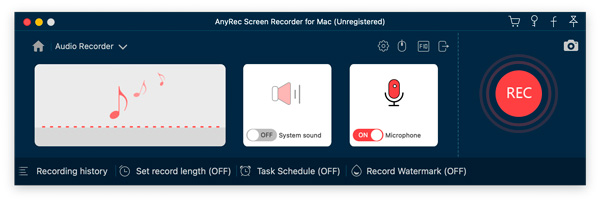
Step 3.Click the "Rec" button to record microphone audio on Mac.
Step 4.When you stop Audio recording, you can pre-listen and trim it.
Step 5.Save or share your Mac audio recording within the program.

#2. Voice Memos
- Best for: Record voice and save it to M4A format on Mac. Integrate with iCloud sharing.
Voice Memos can turn your Mac, iPhone, iPad, and even Apple Watch into a portable audio recorder. So you can quickly record thoughts, ideas, lectures, and meetings. To share voice memos to non-Apple devices, just manually convert them to MP3.
Step 1.Open Launchpad and search for Voice Memos.
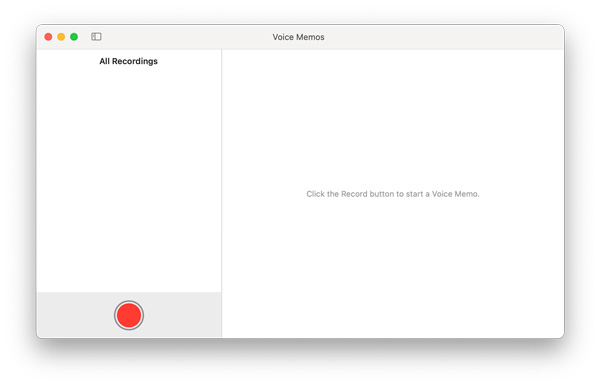
Step 2.Click the "Record" button on the lower left corner.
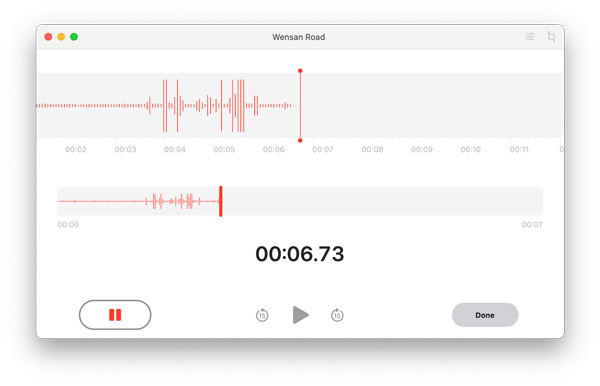
Step 3.Pause, resume, and stop audio recording on Voice Memos.
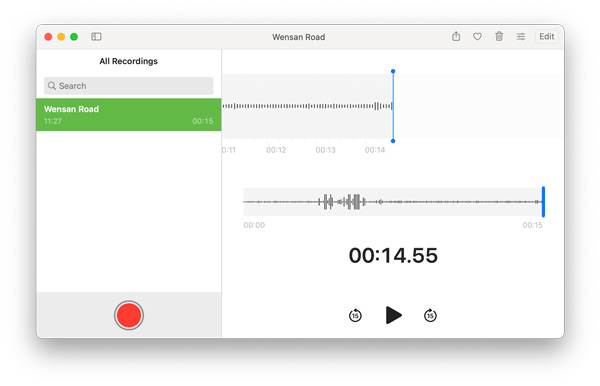
Step 4.Right-click on this recording file. You can edit, trim, duplicate, or get more services.
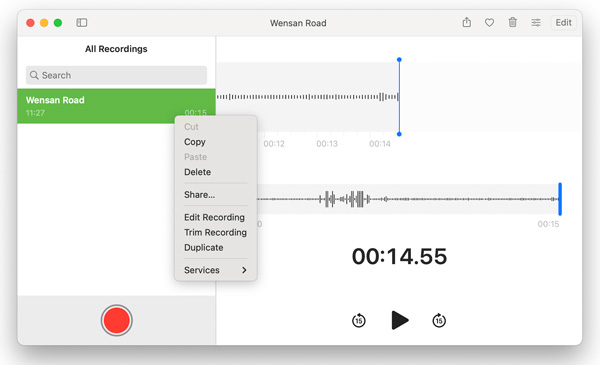
FAQs
-
Why is my Mac not recording audio?
Many reasons can lead to Mac audio recording issues, such as no input audio device selected, the lack of a virtual audio driver, etc. To bypass audio recordings that are not available, you can use the free trial of AnyRec Screen Recorder.
-
Why do I get noises when recording internal audio files on Mac?
If you are listening through speakers rather than headphones, it may cause some noises from monitoring the microphone, which will ruin recordings and potentially damage speakers. Just turn off your speakers and use headphones when recording Internal audio on Mac.
-
Is it possible to edit the audio recording within Voice Memo on Mac?
Yes, of course. You can trim a memo from the beginning or end or both, during your recording session or after the fact. Moreover, the audio recorder also enables you to remove some unwanted parts and share the recording on social media websites.
-
What to do if Voice Memos is not working?
Force quit and restart the Voice Memos app. If the problem still exists, restart your Mac computer. You can also use other audio recording software.
-
How to record audio on Mac from the Internet?
Choose the Mac audio recorder you prefer. Head to its audio recorder. Open the streaming audio on your browser. Now, you can click the Record button to record web audio.
-
How to record audio on Mac with an external microphone?
Ensure you select the external audio device as the input audio source. Later, you can use the above tools to record using the external microphone on Mac.
Conclusion
All in all, you can record audio on Mac from internal and external sources using AnyRec Screen Recorder, QuickTime Player, Voice Memos, and many other excellent programs. You can check the benefits of each tool to find your ideal fit. For quick and high-quality audio recording, click the Free Download below to try now.
Secure Download
Secure Download
